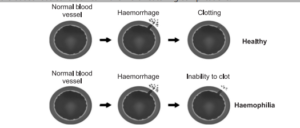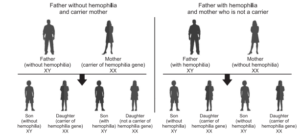Hemophilia Definition | What is Hemophilia
Hemophilia is an inherited bleeding disorder in which a person lacks or has low levels of
“clotting factors”. And as a result, the blood does not clot properly which leads to excessive
bleeding. There are 13 types of clotting factors, and these work with platelets to help in formulation of blood clot. According to the World Federation of Hemophilia 9WFH) about
one in 10,000 people are born with this disease. People with hemophilia bleed easily, and the blood takes a longer time to clot. People with hemophilia can experience spontaneous or internal bleeding and often have painful, swollen joints due to bleeding into the joints. This rare but serious condition can have life-threatening complications.

Causes of Hemophilia And Some Of Its Types
A process in body that is known as “the coagulation cascade” normally pools blood
cells together to form a clot to stop bleeding. Blood platelets (platelets and plasma proteins) coagulate, or gather together at the wound site, to form a clot. Then the body’s clotting factors work together to create a more permanent plug in the wound. Hemophilia occurs when there is a low level of these clotting factors or the absence of them causes bleeding to continue. Hemophilia is inherited. However, about 30 % of people with hemophilia have no family history of the disorder. In these, people hemophilia is caused by a genetic change (spontaneous mutation). The three forms of hemophilia are
hemophilia A, B and C, and these are classified according to which clotting factor
is deficient:
- Hemophilia A: Hemophilia A is the most common type of hemophilia, and it is caused by a deficiency in factor VIII. According to the National Heart, Lung and Blood Institute (NHLB), eight out of ten people with hemophilia have hemophilia A.
- Hemophilia B: Hemophilia B is also called Christmas disease, which is caused by a deficiency of factor IX.
- Hemophilia C: Hemophilia C is a mild form of the disease caused by a deficiency of factor XI. People with this rare type of hemophilia often do not experience spontaneous bleeding. Haemorrhaging typically occurs after trauma or surgery. Hemophilia is an inherited genetic condition which is not curable, but it can be treated to minimize symptoms and prevent future health complications. In extremely rare cases, hemophilia can develop after birth called “acquired hemophilia”. This is the case in people whose immune system forms antibodies that attack factors VIII or IX.

Hemophilia inheritance: Everyone has two sex chromosomes, one from each parent. A female inherits an X chromosome from her mother and an X chromosome from her father. A male inherits an X chromosome from his mother and a Y chromosome from his father. Hemophilia inheritance depends on the type of hemophilia:
- Hemophilia A or B: The gene that causes them is located on the X chromosome, so it can not be passed from father to son. Hemophilia A or B almost always occurs in boys and is passed from mother to son through one of the mother’s genes. Most women with the defective gene are simply carriers and experience no signs or symptoms of hemophilia. Women can experience bleeding symptoms if their factor VIII or IX is moderately decreased.
- Hemophilia C: This disorder can be passed on to children by either parent. Hemophilia C can occur in girls as well as boys.
Related Reads
Acquired Hemolytic Anemia Symptoms Treatment &Diagnosis | Prevention
Anemia Risk Factors & Pathophysiology Of Its Types | Haematological Disease
Diagnosis & Treatment Chronic Obstructive Airways Diseases (COPD)
Acute Bronchitis | What Is Bronchitis | Symptoms Diagnosis Treatment
Emphysema Definition | What Is It ? Risk Factors & Causes
Blood Flow Through the Heart | Electrocardiogram | Heart Sounds

